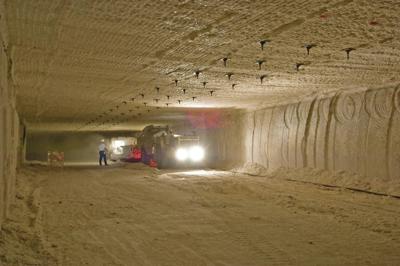[Michelle Lujan Grisham] sided with residents’ contention — which she has stated in the past — New Mexico shouldn’t be home to the nation’s sole nuclear waste storage site.
“The petitioners would like to see the DOE develop a new disposal site in a state other than New Mexico,” she wrote in the letter.
| April 18, 2022 santafenewmexican.com

Gov. Michelle Lujan Grisham is asking the Department of Energy to be more open about its plans to dilute and dispose of surplus plutonium and to address concerns by New Mexico residents about the radioactive materials that would be shipped through the state multiple times.
In a letter to Energy Secretary Jennifer Granholm, the governor cited a 1,146-signature petition her office received in which residents expressed uneasiness about the agency’s vague plans to dilute dozens of metric tons of plutonium — which partly would be done at Los Alamos National Laboratory — before disposing of it at an underground site in Carlsbad.
Plutonium is far more radioactive than the transuranic waste — contaminated gloves, equipment, clothing, soil and other materials — the lab normally sends to the Waste Isolation Pilot Plant to embed in salt caverns deep in the Earth.
The plutonium shipments would travel through a dozen states and cover 3,000 miles — and would go through Santa Fe twice in different forms. A large portion of the surplus is 26 metric tons of castoff plutonium bomb cores, or pits, now stored at the Pantex Plant in Amarillo, Texas.
“The petition reflects ongoing frustration among New Mexicans regarding the lack of meaningful and transparent public engagement from the DOE on waste clean-up, shipments, and long-term plans for the WIPP,” Lujan Grisham stated in the letter. “As Governor, I take these concerns seriously and request that the Department of Energy take action to address the issues raised by New Mexicans.”
The petition drew signatures from Santa Fe, Albuquerque, Gallup, Roswell, Las Cruces, Alamogordo, Silver City and Tucumcari, among others.
Cindy Weehler, who co-chairs the watchdog group 285 ALL, said she was happy the governor has broken her silence on this matter.
“We’re very glad she seems to be engaged on the issue and listening,” Weehler said. “What we appreciate getting from the governor is her recognition that this is frustrating to the residents of New Mexico who are being put at risk but not being told they’re being put at risk.”
Santa Fe County Commissioner Anna Hansen, another vocal critic of the plan, thinks Lujan Grisham’s letter should carry weight with the energy secretary.
“I think it will get Granholm’s attention because it’s coming from the governor,” Hansen said.
A spokeswoman for the National Nuclear Security Administration, an Energy Department branch, said Monday the agency needed more time to provide a response to the letter.
The Energy Department issued a notice of intent in December 2020 to begin drafting an environmental impact statement as one of the first steps toward diluting and disposing of plutonium left over from the Cold War.
The notice hints “downblending” the plutonium would be necessary to reduce radioactivity enough for the waste to be accepted at WIPP.
Weehler and other critics of this plan contend decades-long agreements and at least one law forbid WIPP from taking weapons-grade plutonium, even in diluted form.
Although the Energy Department is saying little about its plans, the National Academy of Sciences describes how as much as 50 metric tons of plutonium would be transported, reconstituted and disposed of at WIPP in its April 2020 analysis.
This plutonium would be sent to the Los Alamos lab, where it would be turned into an oxide powder, and then the powder would be shipped to the Savannah River Site in South Carolina, where it would be further diluted before returning to New Mexico for storage at WIPP.
It’s not known the type of containers that would hold the powder while it’s transported.
Weehler has said if a truck accident breached a container and the powder was released, it would be toxic to breathe in, embedding in lung tissue for years and increasing the chance of cancer.
Lujan Grisham touched on critics’ arguments the increased waste volume would exceed WIPP’s limits under federal law.
The governor also sided with residents’ contention — which she has stated in the past — New Mexico shouldn’t be home to the nation’s sole nuclear waste storage site.
“The petitioners would like to see the DOE develop a new disposal site in a state other than New Mexico,” she wrote in the letter.
State Sen. Jeff Steinborn, D-Las Cruces, said he is with the governor in seeking more openness from the federal officials about the plans, saying there are more questions than answers.
“New Mexico needs to be shown the proper respect that all citizens deserve for their public safety and their health,” said Steinborn, who chairs the Legislature’s Radioactive and Hazardous Materials Committee. “This is a proposal that definitely should be scrutinized and carries certain risks and exposure to the state.”
